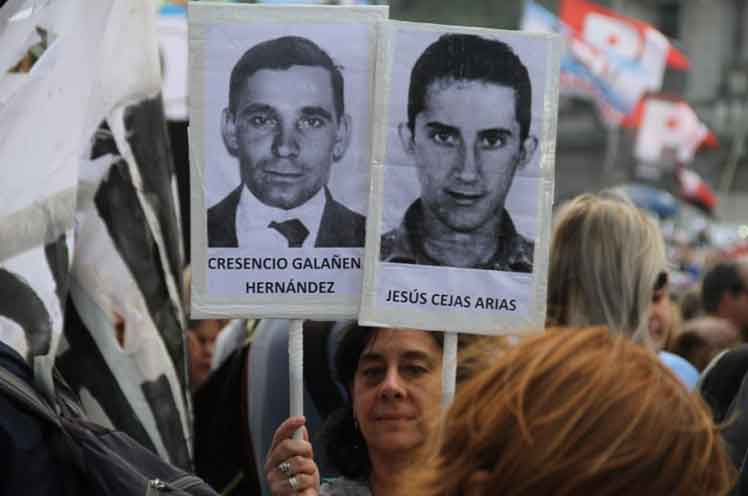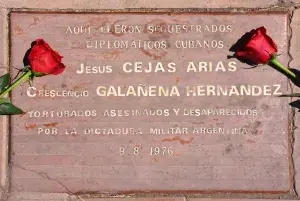
Jesús Cejas Arias and Crescencio Galañena are among the 5,577 Cuban victims of the Argentine military dictatorship (1976-1983). Photo: Presna Latina.

Orinoco Tribune – News and opinion pieces about Venezuela and beyond
From Venezuela and made by Venezuelan Chavistas

Jesús Cejas Arias and Crescencio Galañena are among the 5,577 Cuban victims of the Argentine military dictatorship (1976-1983). Photo: Presna Latina.
By José Luis Méndez Méndez – Aug 9, 2023
The fascist groups within the terrorists of Cuban origin immediately allied with the September 1971 Chilean coup plotters and set out to serve them with the knowledge acquired from their CIA training and the skill acquired in decades of exercising terror as a method of achieving their objectives. This alliance of mutual convenience allowed them to acquire other knowledge that were previously not in their long list of aggressions, such as the much used kidnapping and disappearance of people so common at that time in the Southern Cone of Latin America. They even began to carry it out with the participation of their advisors.
In January 1983, the newspaper La Crónica, of San Juan, Puerto Rico, published a report on the terrorist group of fascists of Cuban origin, who tried to kidnap the Cuban consul in Mérida, Yucatán, México, on July 23, 1976, and to demolish with explosives the Cuban embassy in Mexico City. In this act of terror, Cuban citizen Artaigñan Diaz Diaz was murdered.
Just two weeks after the failed attempt, on August 9, 1976, two young Cuban diplomats were kidnapped, tortured to death and disappeared in Buenos Aires, Argentina, and the extremist organization Coordination of United Revolutionary Organizations (CORU) claimed responsibility for the heinous act. Their remains were found 30 years later as a result of a thorough investigation by Cuban investigators that lasted ten years.
Biden Calls Cuba ‘Terrorist’ While the People Demand an End to US Terrorism Against Cuba

The story of that somber day, when the two were kidnapped, after leaving work, as they were on their way to their homes, and taken to one of the most dreadful torture centers called the Automotores Orletti, the clandestine headquarters, torture and extermination center of Operation Condor in Buenos Aires. This place, now a Space for Memory, was a huge mechanic workshop turned into an “open gallery of death” disguised in a two-storey house, a gloomy place where the detainees’ heart wrenching screams or the cries of the children who were kidnapped with their parents (as revealed by subsequent investigations) could not be heard from outside. Meanwhile, next door, children from an adjoining school, oblivious to the barbarity, played and sang children’s songs while death hovered nearby.
In this clandestine center, during the time it functioned between May and November 1976, the two Cubans appear registered in official Argentinian records, which contain lists of the thousands of disappeared, as numbers 40 and 41. This was later confirmed by testimony that they were the Cuban diplomats Jesús Cejas Arias and Crescencio Galañena Hernández who were subjected to torture until they died, after they were abducted on August 9, 1976 off the streets in the Belgrano neighborhood of Buenos Aires.
It took a decade of investigation to discover the truth, to conclude the real possibility that both young men had suffered the fate of the victims murdered in Automotores Orletti, their corpses, as part of the the sinister methodology of the dictatorship, were then placed in 200 liter oil barrels, mixed with cement, and then thrown in a dump where they remained for more than 36 years.
It is known, through a primary source, that the Cubans endured the worst torture, without revealing any information of interest to their captors. It will always remain as a sign of ideological fortitude, conviction, loyalty, an attitude that had to be recognized by those who murdered them by means of the so-called “dry submarine,” consisting of placing a plastic bag over their heads until they suffocated and died.
There were months of anguish, rrgarding the whereabouts of their remains, and a mixed feeling especially when eight corpses found on October 14, 1976, in the San Fernando Canal were exhumed, some of them identified as coming from Orletti, but none of them were remains of the two Cuban diplomats.
Finally, in June 2012, an unexpected finding happened in the San Fernando area, in a huge garbage dump, where three barrels with human remains inside were found, bringing light after thousands of days of darkness in the search for and for the Cubans. The barrels dated back at least 30 years and were similar to others found earlier. Once identified, a truth was revealed, that although there were common points, there were also differences that distinguished them from those found previously. All those who came from Orletti had been killed with shots in the back of the head, except for a young pregnant woman at full term, who was shot in the pelvis and in the back of the head; they had been kidnapped in September 1976 and another who was kidnapped in July, linked to that group. Now the three barrels found, had all been kidnapped in the first half of August 1976, two had links with the Cuban embassy in Argentina: Maria Rosa Clementi de Cancere, Argentinean teacher kidnapped on the 3rd of that month, and the diplomat Crescencio Galañena Hernández, kidnapped on the 9th. So where was the other Cuban?
This news was revealed, after the verification process was concluded, on August 3, 2012. The other remains had been recognized: those of Ricardo Manuel González, Argentinian kidnapped on August 4, 1976, son of a senior officer of the Argentinian Federal Police and those of the aforementioned young María Rosa. It was a unique moment. It seemed impossible that the search of so many years would end there, in what was left of the remains. The lie and the wait were over, but the anxiety continued: Jesús had yet to be found. On April 18, 2013, in the same place where the previous discovery was made, in front of the international airfield of San Fernando, a rusty metal barrel was found, a few meters away from the place of the previous discovery. It was somewhat deteriorated and inside there were human remains. Hope and fear again. This finding so full of symbolism would culminate, after a series of inquiries, confirming that the remains was that of the Cuban Jesús Cejas Arias.
Everything came to life again. In both cases, the remains were placed in urns and were exhibited at the Cuban embassy headquarters, in the same building from where the two young men left on that fateful day in August 1976. Thousands of Argentinians, together with government authorities, political activists, showed solidarity with Cuba and the cause of the disappeared by making an honor guard in a long mournful line at the embassy. The deep pain that overwhelmed the members of the embassy, and at the same time, the tranquility “beyond the pain” of having been able to reach the tragic conclusion of this story and bring peace to their families and communities back in Cuba for having recovered the remains of their own, from the “night and the fog.” An unforgettable crime that will always be in the historical memory of the aggressions against Cuba.
(Resumen Latinoamericano – English)
You must be logged in to post a comment.